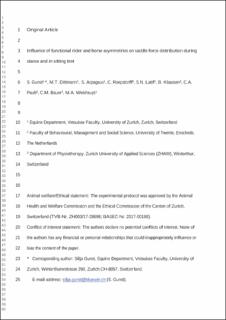Please use this identifier to cite or link to this item:
https://doi.org/10.21256/zhaw-3286Full metadata record
| DC Field | Value | Language |
|---|---|---|
| dc.contributor.author | Gunst, Silja | - |
| dc.contributor.author | Dittmann, Marie T. | - |
| dc.contributor.author | Arpagaus, Samuel | - |
| dc.contributor.author | Roepstorff, Christoffer | - |
| dc.contributor.author | Latif, Selma N. | - |
| dc.contributor.author | Klaassen, Bart | - |
| dc.contributor.author | Pauli, Carole A. | - |
| dc.contributor.author | Bauer, Christoph M. | - |
| dc.contributor.author | Weishaupt, Michael A. | - |
| dc.date.accessioned | 2019-05-03T10:21:01Z | - |
| dc.date.available | 2019-05-03T10:21:01Z | - |
| dc.date.issued | 2019 | - |
| dc.identifier.issn | 0737-0806 | de_CH |
| dc.identifier.uri | https://digitalcollection.zhaw.ch/handle/11475/17027 | - |
| dc.description.abstract | Asymmetric forces exerted on the horse's back during riding are assumed to have a negative effect on rider–horse interaction, athletic performance, and health of the horse. Visualized on a saddle pressure mat, they are initially blamed on a nonfitting saddle. The contribution of horse and rider to an asymmetric loading pattern, however, is not well understood. The aim of this study was to investigate the effects of horse and rider asymmetries during stance and in sitting trot on the force distribution on the horse's back using a saddle pressure mat and motion capture analysis simultaneously. Data of 80 horse-rider pairs (HRP) were collected and analyzed using linear (mixed) models to determine the influence of rider and horse variables on asymmetric force distribution. Results showed high variation between HRP. Both rider and horse variables revealed significant relationships to asymmetric saddle force distribution (P < .001). During sitting trot, the collapse of the rider in one hip increased the force on the contralateral side, and the tilt of the rider's upper body to one side led to more force on the same side of the pressure mat. Analyzing different subsets of data revealed that rider posture as well as horse movements and conformation can cause an asymmetric force distribution. Because neither horse nor rider movement can be assessed independently during riding, the interpretation of an asymmetric force distribution on the saddle pressure mat remains challenging, and all contributing factors (horse, rider, saddle) need to be considered. | de_CH |
| dc.language.iso | en | de_CH |
| dc.publisher | Elsevier | de_CH |
| dc.relation.ispartof | Journal of Equine Veterinary Science | de_CH |
| dc.rights | Licence according to publishing contract | de_CH |
| dc.subject | Horse–rider interaction | de_CH |
| dc.subject | Collapse | de_CH |
| dc.subject | Saddle pressure | de_CH |
| dc.subject | Tilt | de_CH |
| dc.subject | Inertial measurement unit | de_CH |
| dc.subject.ddc | 571: Physiologie und verwandte Themen | de_CH |
| dc.subject.ddc | 590: Tiere (Zoologie) | de_CH |
| dc.title | Influence of functional rider and horse asymmetries on saddle force distribution during stance and in sitting trot | de_CH |
| dc.type | Beitrag in wissenschaftlicher Zeitschrift | de_CH |
| dcterms.type | Text | de_CH |
| zhaw.departement | Gesundheit | de_CH |
| zhaw.organisationalunit | Institut für Physiotherapie (IPT) | de_CH |
| dc.identifier.doi | 10.21256/zhaw-3286 | - |
| dc.identifier.doi | 10.1016/j.jevs.2019.03.215 | de_CH |
| zhaw.funding.eu | No | de_CH |
| zhaw.originated.zhaw | Yes | de_CH |
| zhaw.pages.end | 28 | de_CH |
| zhaw.pages.start | 20 | de_CH |
| zhaw.publication.status | submittedVersion | de_CH |
| zhaw.volume | 78 | de_CH |
| zhaw.publication.review | Peer review (Publikation) | de_CH |
| zhaw.funding.zhaw | Rückengesundheit der Schweizer Pferdepopulation | de_CH |
| Appears in collections: | Publikationen Gesundheit | |
Files in This Item:
| File | Description | Size | Format | |
|---|---|---|---|---|
| Influence_functional_rider_horse_asymmetrics-preprint.pdf | 627.54 kB | Adobe PDF |  View/Open |
Show simple item record
Gunst, S., Dittmann, M. T., Arpagaus, S., Roepstorff, C., Latif, S. N., Klaassen, B., Pauli, C. A., Bauer, C. M., & Weishaupt, M. A. (2019). Influence of functional rider and horse asymmetries on saddle force distribution during stance and in sitting trot. Journal of Equine Veterinary Science, 78, 20–28. https://doi.org/10.21256/zhaw-3286
Gunst, S. et al. (2019) ‘Influence of functional rider and horse asymmetries on saddle force distribution during stance and in sitting trot’, Journal of Equine Veterinary Science, 78, pp. 20–28. Available at: https://doi.org/10.21256/zhaw-3286.
S. Gunst et al., “Influence of functional rider and horse asymmetries on saddle force distribution during stance and in sitting trot,” Journal of Equine Veterinary Science, vol. 78, pp. 20–28, 2019, doi: 10.21256/zhaw-3286.
GUNST, Silja, Marie T. DITTMANN, Samuel ARPAGAUS, Christoffer ROEPSTORFF, Selma N. LATIF, Bart KLAASSEN, Carole A. PAULI, Christoph M. BAUER und Michael A. WEISHAUPT, 2019. Influence of functional rider and horse asymmetries on saddle force distribution during stance and in sitting trot. Journal of Equine Veterinary Science. 2019. Bd. 78, S. 20–28. DOI 10.21256/zhaw-3286
Gunst, Silja, Marie T. Dittmann, Samuel Arpagaus, Christoffer Roepstorff, Selma N. Latif, Bart Klaassen, Carole A. Pauli, Christoph M. Bauer, and Michael A. Weishaupt. 2019. “Influence of Functional Rider and Horse Asymmetries on Saddle Force Distribution during Stance and in Sitting Trot.” Journal of Equine Veterinary Science 78: 20–28. https://doi.org/10.21256/zhaw-3286.
Gunst, Silja, et al. “Influence of Functional Rider and Horse Asymmetries on Saddle Force Distribution during Stance and in Sitting Trot.” Journal of Equine Veterinary Science, vol. 78, 2019, pp. 20–28, https://doi.org/10.21256/zhaw-3286.
Items in DSpace are protected by copyright, with all rights reserved, unless otherwise indicated.